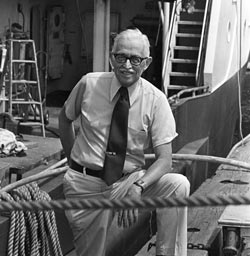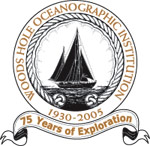This is an archived site. This site is no longer being maintained or reviewed for broken links.
Employee Portrait Gallery—Paul Fye
 |
|
|
Paul Fye and Chain (behind Fye) arrived at WHOI the same year, the new director with a mandate for organizational change and Chain heralding the advent of big-ship oceanography. (Photo by Vicky Cullen) |
|
As the Institution’s fourth director, from 1958 to 1977, Paul Fye presided over a period of major change. It was a time of great national interest in basic science, including oceanography, and the resulting boost in federal support for marine science allowed considerable expansion. During Fye’s tenure as a visionary director, the number of WHOI employees doubled, and the operating budget increased nearly tenfold, from about $2.5 million in 1958 to $24 million in 1977. The first departmental organization was instituted in 1962. On June 18 that year, the keel was laid for Atlantis II in Baltimore while ground was broken in Woods Hole for the Redfield Laboratory. Alvin joined the fleet two years later, and Knorr and Oceanus arrived in 1970 and 1975, respectively. The Institution acquired the Quissett Campus in the late 1960s, and the Clark Laboratory, still WHOI’s largest building, was occupied in 1974. Fye was the driver for two important new directions for the Institution— the MIT/WHOI Joint Program began in 1968, and the marine policy program in 1971. He was also a national leader in ocean sciences for implementation of the University National Oceanographic Laboratory System (UNOLS) and other ocean science community collaborations.
Paul Fye was not a stranger to Woods Hole when he became director. A physical chemist (B.S. from Albright College in 1935 and Ph.D. from Columbia University in 1939), he taught briefly at Hofstra College before joining a National Defense Research Council project in underwater explosives in 1941. The following year, he came to Woods Hole with a Harvard University-based underwater explosives group that needed to move its noise away from Cambridge (in Woods Hole, they were known as the “boom boys”). His expertise was in chemical additives, depth charge behavior, and the destructive effects of underwater explosives. By 1946, he was the group’s research director. After another brief teaching engagement, Fye served as a manager at the Naval Ordnance Laboratory in Washington, DC, until the WHOI board called him to become director of the Institution in 1958.
[back]

